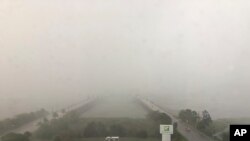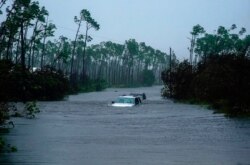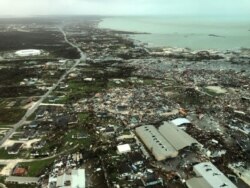Hurricane Dorian, weakened but still potent, advanced up the southeastern U.S. coastline Wednesday, threatening shoreline communities with dangerous storm surges and the possibility it still might make landfall in the U.S.
As the Bahamas began to assess the devastation Dorian wreaked on the normally idyllic vacation mecca, U.S. hurricane forecasters said the storm, still packing 165 kilometer-an-hour winds, was positioned off the northeastern coast of Florida and tracking close to the U.S. mainland.
The National Hurricane Center said the storm, advancing at 15 kilometers an hour, will continue to parallel the Florida and Georgia coastlines through Wednesday night. Then, the agency predicted, the storm "is forecast to move near or over the coast of South Carolina and North Carolina Thursday through Friday."
The hurricane agency said the storm surge could reach two meters or more above normal waves, potentially inundating low-lying areas in numerous mid-Atlantic coastal communities. Hurricane force winds extend outward 110 kilometers from the storm's eye, and tropical force winds 280 kilometers.
U.S. President Donald Trump was briefed on the storm at the White House, saying, "We don't know where the hurricane is turning. We certainly got lucky in Florida. It's a very erratic, very slow, very powerful hurricane."
Forecasters said the hurricane is now classified as a Category 2 storm, diminished from a Category 5 when it hit the Bahamas days ago and relentlessly battered the islands, flooding neighborhoods, destroying thousands of houses, ripping roofs off buildings and leaving thousands of people in need of aid.
Prime Minister Hubert Minnis said there were seven confirmed deaths from the storm, but that the number was expected to increase. He pledged, "No effort or resources will be held back," in responding to the disaster.
The hurricane agency said flood waters on Grand Bahama and Abaco islands should start to slowly recede.
Aid efforts have been hampered by the long duration of the storm as it sat over the islands and pummeled the area with strong winds and rain, leaving the runway at Grand Bahama Airport under water.
The Red Cross said Dorian severely damaged or destroyed nearly half the homes on Grand Bahama and Abaco and that 62,000 people were in need of clean water. The United Nations said about 60,000 people need food after the storm.
"Right now there are just a lot of unknowns," Bahamian lawmaker Iram Lewis said, adding, "We need help."
Minnis said, "We are in the midst of one of the greatest national crises in our country's history."















